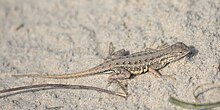en
names in breadcrumbs


Keeled earless lizards are endemic to southern Texas and coastal Mexico, which means that they are found no where else. So if anything happens to their habitat they could become endangered or even worse, extinct.
US Federal List: no special status
CITES: no special status
IUCN Red List of Threatened Species: least concern
Unknown
These lizards may benefit humans by helping control insect populations (Behler and King 1979).
Keeled earless lizards are insectivorous, which means that they hunt down and eat insects. It is unknown which insects these lizards prefer. They seem to eat whatever they can get ahold of. They are diurnal, so they are only active and forage for food during the day and not at night. It may get too cold for them at night, as they are cold blooded animals (Cochran and Goin 1970; Behler and King 1979).
Primary Diet: carnivore (Insectivore )
This lizard species lives only in Southern Texas and coastal northeastern Mexico, as far south as Guanajuato. You won't find these unique lizards anywhere else (Behler and King 1979).
Biogeographic Regions: nearctic (Native )
Keeled earless lizards are endemic to barrier beaches and sand dumes. Some prefer to live closer to the coast than others, but all of them prefer to live in dry sandy places. There are unique adaptions that Keeled earless lizards have, that allows them to live on sandy habitats. For a small lizard, they have long legs and feet for getting around at relatively fast speeds on the sand. Their blotched coloring gives them the advantage of camouflage. Burrowing into sand to hide and regulate their temperature is made easier by the shape of their head. The sand dunes on Padre Island on the Texas coast is one place where there are many keeled earless lizards. (Behler and King 1979; Bechtel 1995)
Terrestrial Biomes: desert or dune
These are small lizards that have no external ear opening, and have a tail that is longer than their head and body. They range from 11-14.1cm (4 1/2 to 5 9/16 in.) in length. Maximum head and body length is 7 cm (2 3/8 in.), so the tail can be about as long as 7.6 cm (3 in.). However, these lizards often lose part of their tails to predators, and can grow a new one, so tail length is not a good characteristic for identification. Unlike the other species of earless lizards (all genus Holbrookia), they have tiny keels on their dorsal scales. Their scales are granular, meaning they do not over lap and very small. The males and females have different and unique markings that are useful in telling them apart. The males have large black bands on either side of their stomach. The females are lighter in color and lack the black bands. Most of the males and females have irregular patterns of brown and grey stripes and blotches that cover their back and head (Conant 1958; Behler and King 1979).
Keeled earless lizards have femoral pores on each hind leg. There are on average 14-15, but they can have as many as 20. The femoral glands open into the dermal follicles. It is not known what they do exactly, but it is agreed that they are used for reproduction. Since they are diurnal, they have fairly good vision. They rely on their vision for courtship. They have very noticable sexual dimorphism. The male and female coloring is very important. The female coloring is controlled by hormones. When they change colors, it is a signal to males that they are ready to mate. Like most lizards, Keeled earless lizards are oviparous. Females have unique coloring when they are carrying eggs. They tend to be orange or pink. The female digs a burrow in which to deposit her eggs. After hatching, their young on average are 3.8 cm (1 1/2") long and have the same blotchy coloring as the adults (Cochran and Goin 1970; Conant 1958; Bechtel 1995; Cogger and Zweifel 1998).

Holbrookia propinqua (keeled earless lizard) is a species of phrynosomatid lizard.
The dorsal scales are small, pointed, and keeled, as the common name implies. The lateral scales are similar but smaller. The ventral scales, which are flat and smooth, are 3-4 times larger than the dorsal scales. Adults may attain 62 mm (2+1⁄2 in) snout to vent length (SVL), 140 mm (5+1⁄2 in) total length.[1]
Holbrookia propinqua occurs in the Tamaulipan mezquital ecoregion where it is known from various vegetation zones in south Texas, including mixed oak forest, mesquite brush-lands, cleared fields, coastal prairie, and grasslands, although always where bands of Tertiary sand outcrops or sandy stream-side deposits are found. It is perhaps most common in the loose and shifting sands of beaches, barrier islands, and the Coastal Sand Plain of Southern Texas. It also ranges into northeast Mexico but it is highly restricted to the narrow zone of sand dunes of the coastal beaches, peninsulas, and barrier islands of Tamaulipas and southward to the vicinity of Veracruz, Veracruz.[2][3]
There are three recognized subspecies of Holbrookia propinqua:
 Geographic distribution of the keeled earless lizard (Holbrookia propinqua).
Geographic distribution of the keeled earless lizard (Holbrookia propinqua).  Keeled earless lizard (Holbrookia propinqua) male, Padre Island National Seashore, Kleberg Co. TX; 2 Nov 2022
Keeled earless lizard (Holbrookia propinqua) male, Padre Island National Seashore, Kleberg Co. TX; 2 Nov 2022  Keeled earless lizard (Holbrookia propinqua) female, municipality of Soto La Marina, Tamaulipas, Mexico (20 May 2002).
Keeled earless lizard (Holbrookia propinqua) female, municipality of Soto La Marina, Tamaulipas, Mexico (20 May 2002). Holbrookia propinqua (keeled earless lizard) is a species of phrynosomatid lizard.